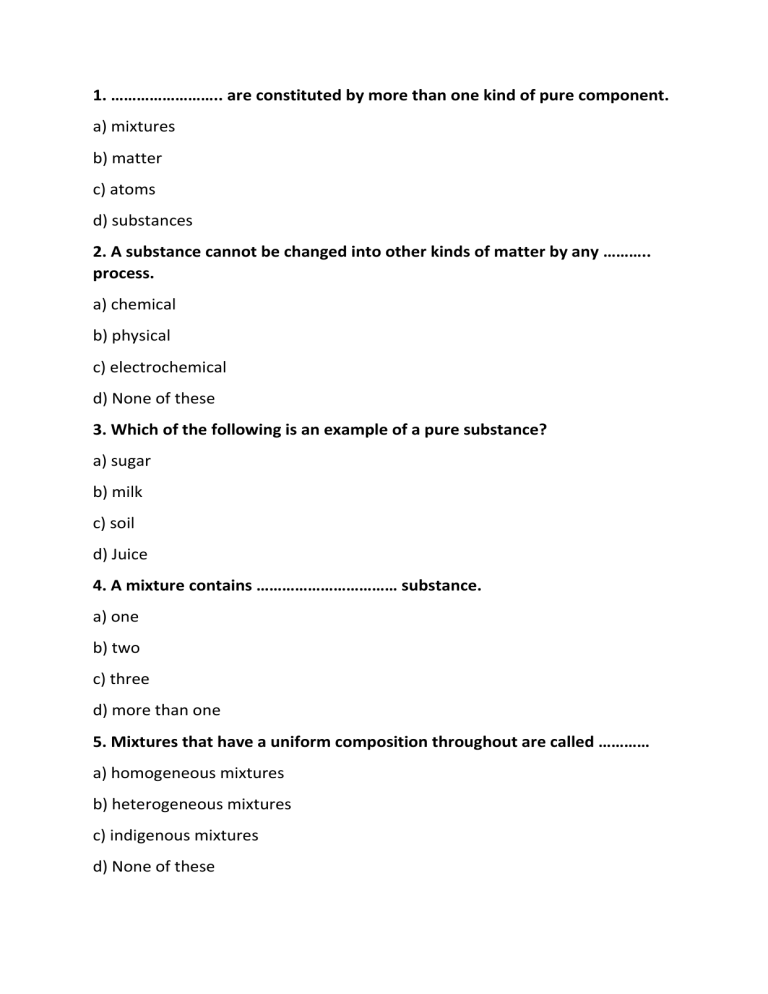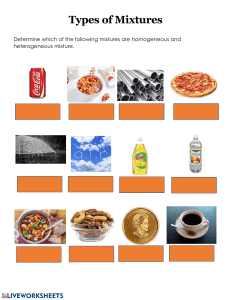
1. …………………….. are constituted by more than one kind of pure component. a) mixtures b) matter c) atoms d) substances 2. A substance cannot be changed into other kinds of matter by any ……….. process. a) chemical b) physical c) electrochemical d) None of these 3. Which of the following is an example of a pure substance? a) sugar b) milk c) soil d) Juice 4. A mixture contains …………………………… substance. a) one b) two c) three d) more than one 5. Mixtures that have a uniform composition throughout are called ………… a) homogeneous mixtures b) heterogeneous mixtures c) indigenous mixtures d) None of these 6. Mixtures which have non-uniform compositions and physically different parts are called …………. a) homogeneous mixtures b) heterogeneous mixtures c) indigenous mixtures d) None of these 7. Sugar dissolved in water is an example of a ………………………………….. a) homogeneous mixture b) heterogeneous mixture c) indigenous mixture d) None of these 8. A mixture of oil and water is an example of a …………………………………. a) homogeneous mixture b) heterogeneous mixture c) immiscible solution d) heterogeneous immiscible solution 9. When you add chalk powder or wheat flour to water, you get a …………… a) solution b) suspension c) colloidal solution d) None of these 10. Which of the following can be made into crystal? (a) A bacterium (b) An Amoeba (c) A virus (d) A sperm 11. A cell will swell up if (a) the concentration of water molecules in the cell is higher than the concentration of water molecules in the surrounding medium. (b) the concentration of water molecules in the surrounding medium is higher than water molecules concentration in the cell. (c) the concentration of water molecules is same in the cell and in the surrounding medium. (d) concentration of water molecules does not matter. 12. Chromosomes are made up of (a) DNA (b) Protein (c) DNA and protein (d) RNA 13. Which of these options are not a function of ribosomes? (i) It helps in manufacture of protein molecules. (ii) It helps in manufacture of enzymes. (iii) It helps in manufacture of hormones. (iv) It helps in manufacture of starch molecules. (a) (i) and (ii) (b) (ii) and (iii) (c) (iii) and (iv) (d) (iv) and (i) 14.Which of these is not related to endoplasmic reticulum? (a) It behaves as a transport channel for proteins between nucleus and cytoplasm. (b) It transports materials between various regions in the cytoplasm. (c) It can be the site of energy generation. (d) It can be the site for some biochemical activities of the cell. 15. Following are a few definitions of osmosis: Read carefully and select the correct definition. (a) Movement of water molecules from a region of higher concentration to a region of lower concentration through a semi-permeable membrane. (b) Movement of solvent molecules from its higher concentration to lower concentration. (c) Movement of solvent molecules from higher concentration to lower concentration of solution through a permeable membrane. (d) Movement of solute molecules from lower concentration to higher concentration of solution through a semi permeable membrane. 16. Plasmolysis in a plant cell is defined as (a) breakdown (lysis) of plasma membrane in hypotonic medium (b) shrinkage of cytoplasm in hypertonic medium (c) shrinkage of nucleoplasm (d) none of them 17. Which of the following are covered by a single membrane? (a) Mitochondria (b) Vacuole (c) Lysosome (d) Plastid 18. Find out the false sentence. (a) Nucleus is involved with the formation of lysosomes. (b) Nucleus, mitochondria and plastid have DNA, hence they are able to make their own structural proteins. (c) Mitochondria is said to be the power house of the cell as ATP is generated in them. (d) Cytoplasm is called as protoplasm.



